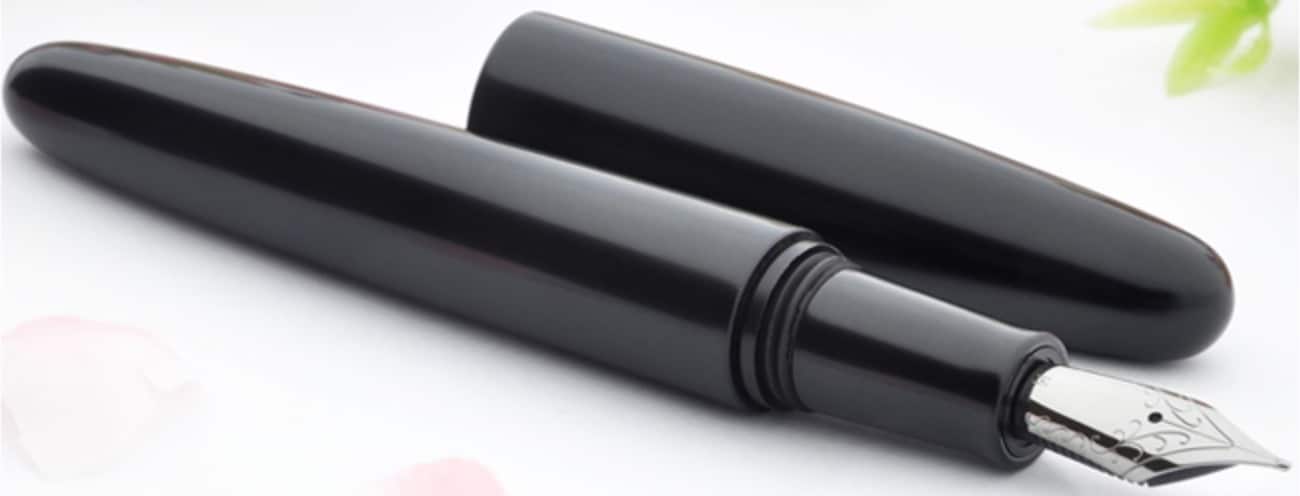If you have been in the market for a nice fountain pen (or at least researching them) then you have almost certainly encountered a material known as ebonite. But what exactly is ebonite, and why are the pens made from it so expensive?
What Is Ebonite?
Ebonite is a material that is a form of hard rubber. The rubber goes through a long vulcanizing process that makes it hard, durable, and highly resistant to chemicals. Vulcanized rubber is also quite wear resistant, which is one reason many vintage ebonite pens have aged so well.
“Ebonite” is actually the brand name of the company that first made this hard rubber, known as Ebonite International. The company used the material in many different applications, including its own brand of bowling bowls which were sold under the brand name of Ebonite. Ebonite might be a brand name, but all forms of hard, vulcanized rubber are generally called “ebonite” within the pen community in the same way that you might refer to a generic facial tissue as a “Kleenex.”
Ebonite is mostly used in the barrel and grip section of a fountain pen, but it can also be used in the feed. Some pens will have a full body made of ebonite while others will only have an ebonite feed. This can be seen in the Aurora Optima pen, as well as a number of pens from Wancher, who will let users customize their pen by offering to upgrade it from a plastic feed to an ebonite one for a surcharge of $40.
Much of today’s ebonite (at least for pens) is made in Japan, by companies like Nikko Ebonite, who, in particular, is known for their manufacturing quality.
Who Makes Ebonite Pens?
Despite ebonite normally being considered an old fashioned material and most desirable in vintage pens, a number of companies still use it. Some of the big names in ebonite fountain pens include (but are not limited to):
- Ranga
- Edison
- Click
- Bexley
- Conid
- Narwhal
- FPR
- Newton
- Wancher
If you are interested in vintage pens there are many more that you can find in ebonite. You can find vintage brands, like Swan, as well as current ones, like Waterman.
A number of Japanese companies make high-end ebonite pens that are coated in urushi (lacquer). Some of these include:
- Wancher
- Sailor (King of Pens series)
- Pilot (Custom Urushi series)
- Eboya
Why Do People Like Ebonite Pens So Much?
When speaking to ebonite fountain pen fans, you’ll hear a few common threads about why they enjoy the material so much.
The most common quality people love in ebonite is the material’s “warmth.” The material has a natural feel to it that is lacking in resin (plastic) pens and missing entirely in metal pens. While the descriptor “warmth” might not mean much to you, the point is that ebonite is pleasant to the touch. It has an organic living feel that many modern pens lack.
Next, ebonite is very chemical resistant. This is particularly useful when a pen is in contact with acidic inks, as many fountain pens are. This means an ebonite pen can be used as an eyedropper pen — basically without a converter which means the ink touches the inside of the fountain pen body. Because of ebonite’s resistance, the pen won’t stain or be otherwise damaged by most inks. Some fountain pen materials, like acrylic and aluminum, can be damaged by ink, which makes them surprising choices in a pen body but ebonite is not such a material.
Ebonite is very easy to form and shape. The material is malleable so simple tools, like a lathe, can be used to form a pen. This means individual pen turners and small brands can be built around ebonite (just like with wood) where such brands would not be able to afford the manufacturing needed to make a pen out of plastic.
Historically, ebonite was used because it was more resistant and malleable than the plastics of the day. Plastics were still in their infancy while ebonite pens were in their prime. By the 1940s plastics had increased enough in their quality that it began to replace ebonite entirely (as seen in pens like the Parker 51).
